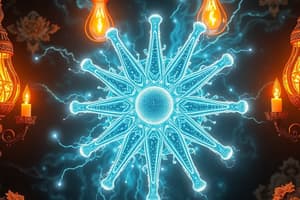Podcast
Questions and Answers
What must exist between two charges for electric work to be done?
What must exist between two charges for electric work to be done?
- Current flow
- Potential difference (correct)
- Electrical resistance
- A magnetic field
What is the unit of electric charge?
What is the unit of electric charge?
- Amperes
- Ohms
- Volts
- Coulombs (correct)
Which of the following best describes electromotive force (emf)?
Which of the following best describes electromotive force (emf)?
- The unit of power
- The resistance encountered by a current
- The measure of potential difference in a circuit (correct)
- The force exerted by a magnetic field
What materials are typically used in dry cell batteries?
What materials are typically used in dry cell batteries?
What happens to the electric field lines between two like charges?
What happens to the electric field lines between two like charges?
What is the basic unit of potential difference?
What is the basic unit of potential difference?
What process converts chemical energy into electrical energy in batteries?
What process converts chemical energy into electrical energy in batteries?
How many electrons correspond to a charge of one coulomb?
How many electrons correspond to a charge of one coulomb?
What is produced when the electrolyte in a battery reacts with zinc?
What is produced when the electrolyte in a battery reacts with zinc?
What phenomenon describes the generation of voltage in certain crystals when mechanically vibrated?
What phenomenon describes the generation of voltage in certain crystals when mechanically vibrated?
Which type of materials emit electrons when exposed to light?
Which type of materials emit electrons when exposed to light?
What is the primary function of solar cells?
What is the primary function of solar cells?
What type of electrical measurement method uses a junction of two different metals?
What type of electrical measurement method uses a junction of two different metals?
What unit is used to measure electrical charge?
What unit is used to measure electrical charge?
How many electrons are present in 1 coulomb of charge?
How many electrons are present in 1 coulomb of charge?
In which direction do positive charges move in a conducting wire when connected to a battery?
In which direction do positive charges move in a conducting wire when connected to a battery?
What does the law of conservation of charge state?
What does the law of conservation of charge state?
What is the main component that produces direct current (DC) voltage?
What is the main component that produces direct current (DC) voltage?
How is one ampere of current defined?
How is one ampere of current defined?
What defines conventional flow of current?
What defines conventional flow of current?
Which term describes an electric quantity used for conveying information?
Which term describes an electric quantity used for conveying information?
What does direct current (DC) do in a circuit?
What does direct current (DC) do in a circuit?
What is the standard unit of current?
What is the standard unit of current?
Who laid the foundation of electrodynamics?
Who laid the foundation of electrodynamics?
Flashcards are hidden until you start studying
Study Notes
Atomic Structure
- Atoms are made up of protons, neutrons, and electrons.
- Protons have a positive charge, electrons have a negative charge, and neutrons have no charge.
- The number of protons in an atom determines its atomic number and its element.
- Electrons orbit the nucleus in shells or energy levels.
Electric Charge
- The magnitude of an electric charge is determined by the difference between the number of electrons and protons.
- The symbol for electric charge is Q, and it is measured in Coulombs (C).
- One Coulomb (C) is equal to 6.24 x 1018 electrons.
Electrostatic Field
- An electric charge creates an electrostatic field around it.
- The electrostatic field exerts a force on other charges in the field.
- Like charges repel each other, and unlike charges attract.
Potential Difference (Voltage)
- The ability of an electric charge to do work is called its potential.
- The difference in potential between two charges is called potential difference or voltage.
- Voltage is represented by the symbol V, and it is measured in Volts (V).
- Electromotive force (EMF) is the total potential difference across all charges in an electric field.
Sources of Electricity
- Batteries: Convert chemical energy into electrical energy. They consist of materials like zinc and carbon or zinc and manganese dioxide.
- Generators: Convert mechanical energy into electrical energy.
- Solar Cells: Convert light energy directly into electrical energy. They are made from semiconductors like silicon.
- Piezoelectric Effect: Certain crystals, like quartz and Rochelle salts, generate a voltage when they are vibrated mechanically.
- Photoelectric Effect: Some materials emit electrons when light strikes their surface. This effect is used in photomultipliers and light sensors.
- Thermocouples: Two dissimilar metals joined together generate a voltage when heated.
Electrical Quantities
- Charge (q): An electrical property of matter, measured in Coulombs (C).
- Current (i): The flow of electrons through a conductor, measured in Amperes (A).
- Voltage (v): The potential difference between two points, measured in Volts (V).
Current Flow
- Conventional Current Flow: Current flows from the positive terminal to the negative terminal of a source.
- Electron Flow: Electrons actually move from the negative terminal to the positive terminal of a source.
Direct Current (DC)
- Direct current (dc) flows in one direction only.
- DC is typically produced by batteries.
Alternating Current (AC)
- Alternating current (ac) changes direction periodically.
- AC is typically produced by generators.
Electric Circuit
- An electric circuit is a closed loop through which electric current can flow.
- Circuits typically consist of a power source, a load, and conductors.
Studying That Suits You
Use AI to generate personalized quizzes and flashcards to suit your learning preferences.




